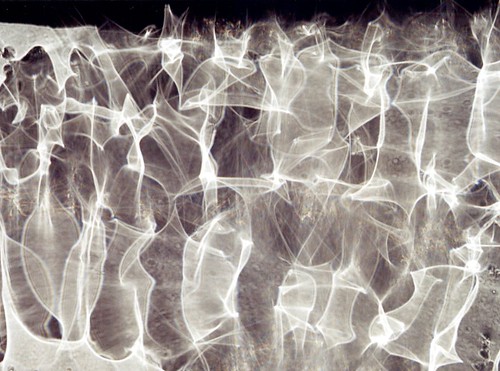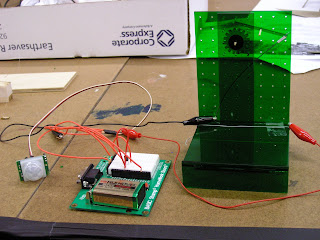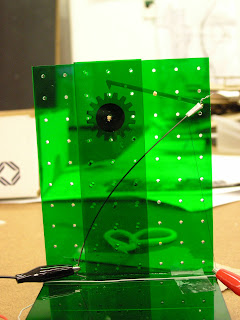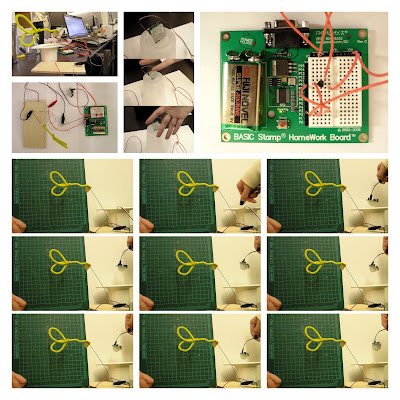Tuesday, May 8, 2007
passing wing2
passing wing1
input
motion sensor input
video
processing
setup delay for the input
HIGH 10
PAUSE 1000
LOW 10
PAUSE 500
video
output
Video
flexinaol

motion sensor input
video
processing
setup delay for the input
HIGH 10
PAUSE 1000
LOW 10
PAUSE 500
video
output
Video
flexinaol

Party Wall


VIDEO
Pitchtest: http://www.youtube.com/watch?v=CiVZmk38j6o
Prototypes: http://www.youtube.com/watch?v=wdoCtQh87UA
Final Prototype: Party Wall: http://www.youtube.com/watch?v=rhfwnYMmG0Q
Party Wall
Typ: a dividing partition between two adjoining units or sides that is shared
Rare: a social surface that activates during increasingly varied pitches of sound
Walls of buildings are usually silent spectators when it comes to socialization. Maybe walls don’t have much to say, or maybe they don’t have a voice with which to speak. Historical tales often begin with sayings such as “Many events have happened within these walls,” or “if these walls could talk,” each implying that walls keep tabs on what happens on either side of them. But we prefer to think of walls as participants in those events. We propose a different wall that reacts to different sounds when and as they occur. In this way, walls show their emotions as reactive to the conversations, discussions or arguments that people have within them.
Our premise began with examining the difference between male and female voices. After cataloging many different voices, we found that the perceived pitch of voices was different than the numeric register of high, medium and low voices. The exhibition of these three ranges of sound became the focus of our prototypes. Different parts of the wall activate with different pitches, creating varying patterns of movement across a surface. Within each conversation, someone’s voice can vary through many different octaves of sound, and the wall is a reactive, responsive system to such stimuli. To process this sound in real-time, we utilized live feeds fed through a microphone, processed by live sound analyzing software that then signal a microcontroller when sounds falling within preset ranges were detected. These signals trigger the movement of memory alloy wires that move to pluck a membrane covered in inflated condoms, amplifying the social potential of a wall’s thickness.
In developing this project, potential directions and applications for such a surface were discussed. We hope that as people discover the responsive nature of the wall, it might invoke them to deliberately manipulate the surface, for instance, by purposefully modulating their own voices or by engaging with others in order to witness an effect. There seems to be great performative implications for socializing with a wall, something that might seem dull at first. In our playing with this patch of wall, it often appeared to have a mind of its own, as there was often a time delay in the reaction within. At times we stopped paying attention to the wall and noticed later that the wall was still capturing subtle differences in tone and mood while we were caught up in conversation. The notion of the wall as pet began to emerge from this observation. The condoms were at first thought to be uncomfortable, humorous, gross and provocative, but as they were inflated and arranged into a soft field they immediately took on a cuter, more comfortable character. Even still, they seem to invoke some sort of hesitancy about physically engaging with sexual forms and accoutrements that are often taboo in public settings.
In the end, the party wall is not only a monitor of vocalized social interactions, but it suggests different ways of occupying space. The relationship becomes a feedback loop whereby the sound of a person’s voice in a room, passively activating a wall, then offers the option to directly perform with their surroundings.
Monday, May 7, 2007
Visible & Hidden
Paranoid Translator
We're quite pleased with how our output is working. The "spikes" move a lot more when the flexinol is supplied with a fresh battery. You can see them move a little in our video, but before we could replace the battery, our installation was torn down, and we were taken to the Department of Public Safety. Pretty dumb on our part to leave our mechanisms unattended in the elevator, but we think it backs up our concept pretty well...


Labels: paranoid
Friday, May 4, 2007
DIY air valve
Flexinol Air Valve
http://www.robotshop.ca/home/suppliers/dynalloy-en/dynalloy-flexinol-air-valve.html
http://www.dynalloy.com/Kits.html
the Dynalloy Flexinol Electrostem Air Valve
is going to take too long to ship. So we are going to pay for the UPS second day...//I found this in AQUARIUM.




archive (trigger group)
Blinking lights + moving wire!!
we finally got our flexinol wire to move along with the lights blinking by using another battery and a relay.
check out the video
Labels: paranoid
REFERENCE PROJECT: Voice Prints
Project that translates voice patterns into a unique design for each user.
http://www.digitalstar.net/projects/voiceprints/index.html
http://www.digitalstar.net/projects/voiceprints/index.html
Wednesday, April 18, 2007
Two sensors/two outputs
Here is our circuit and our code for having two sensors - each controlling a different output.
'{$STAMP BS2}'
{$PBASIC 2.5}
PIR PIN 0
PIR2 PIN 15
counter VAR Byte
Main:
DO
IF PIR = 1 THEN
counter = counter + 1
HIGH 2
DEBUG HOME, "TRIPPED...", DEC3 counter
DO : LOOP UNTIL PIR = 0
DEBUG HOME, "CLEARED...", DEC3 counter
LOW 2
ENDIF
IF PIR2 = 1 THEN
counter = counter +1
HIGH 9
DEBUG HOME, "TRIPPED2...", DEC3 counter
DO : LOOP UNTIL PIR2 = 0
DEBUG HOME, "CLEARED2...", DEC3 counter
LOW 9
ENDIF
LOOP
updates: pando - roufa

.
prototype: waiting room lamp insert
.
description: flexinol controlled blown glass lens subtly shifts position to produce slight modulation of light pattern on ceiling.
.
next steps: fine tune optics and controller, add sensor
.
description: flexinol controlled blown glass lens subtly shifts position to produce slight modulation of light pattern on ceiling.
.
next steps: fine tune optics and controller, add sensor
img. 1________img. 2_______ img. 3
.
three different lens types - img.1: blown glass plate, img. 2: same plate covered with optic lenses, img. 3: blown glass object
Monday, April 16, 2007
presure bubble

//Air cushion // like the air cushion use on a chair. The idea is use pressure sensor as input to control the average pressure between the cushion and body. So the output will be air compresser. and it'll become a feedback loop. (focus: input+output)
Monday, April 2, 2007
Tuesday, March 27, 2007
Speech Recognition Midterm
largest aggregation -
smaller aggregation -
Umbrella arm operation

This is a prototype of the umbrella arm. Components used: modified toilet bolt cap, metal washers, shortened umbrella arm, twine.
Watch video here: http://video.google.com/videoplay?docid=-7935047489177323970
Minimum Movement - Maximum Output

Mark Green / Richard Moore / Fernando Pando / Micha Roufa
http://video.google.com/videoplay?docid=-4894204353890878700
The longer the flexinol, the greater movement.
Switch functions properly. Some fine tuning needs to happen for the LEDs and lenses to align properly.
The wire is wrapped around the screw, so simply tightening the screw increases the tautness of the wire.
Wiring for the LEDs.
The new cross platform motherboard achieves greater much greater movement.
By increasing the pause amount, we achieve approximately 2" of movement.
Monday, March 26, 2007
organ organ midterm
For our video, click here: http://www.youtube.com/watch?v=mUzGWyDpsTo
Quicknotes:
We focused on processing sound by splitting it into high medium and low pitch ranges for multiple output options. Our prototyping efforts were many, but mostly subtle. Still having trouble talking between computer and Arduino board, but we just found out that we have a bum microcontroller.
Quicknotes:
We focused on processing sound by splitting it into high medium and low pitch ranges for multiple output options. Our prototyping efforts were many, but mostly subtle. Still having trouble talking between computer and Arduino board, but we just found out that we have a bum microcontroller.
Labels: Sound Max/MSP Processing Arduino
Thursday, March 22, 2007
Minimum Movement - Maximum Output
Tuesday, March 20, 2007
Wing_00 (make-up post)
Wing_04
Prototype 2.

Overall setup.

The holes on the backboard allows for possible future repositioning of the gear.

The flexinol wire is attached to a spring component (subsituted with the rubberband seen here) that will pull the wire back in place after the flexinol wire relaxes.

The latch is added.
Overall setup.
The holes on the backboard allows for possible future repositioning of the gear.
The flexinol wire is attached to a spring component (subsituted with the rubberband seen here) that will pull the wire back in place after the flexinol wire relaxes.
The latch is added.
























